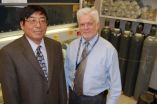(Press-News.org) Investigators at The University of Texas Health Science Center at Houston (UTHealth) have accelerated the search for the bacterial genes that make the Lyme disease bacterium so invasive and persistent. The discovery could advance the diagnosis and treatment of this disease, which affects an estimated 30,000 Americans each year.
The researchers have developed a new technique that allowed them to test 15 times more bacterial genes than had been evaluated in the previous 30 years to ascertain their roles in infection. Findings appeared Oct. 25 in the journal The Public Library of Science ONE (PLOS ONE), an international, peer-reviewed, open-access, online publication.
Scientists hope to use this information to unravel the mystery of how the spiral-shaped bacterium Borrelia burgdorferi causes Lyme disease. Ticks carry the bacterium and transfer it to animals and humans when the tiny spider-like creatures bite. The Lyme disease microorganism was discovered in 1981.
"We believe that this will be one of the most significant publications in Lyme disease in the next several years. This global approach will help 'move the field forward' and also serve as a model for other pathogens with similar properties," said Steven Norris, Ph.D., the study's senior author and the vice chair for research in the Department of Pathology and Laboratory Medicine at the UTHealth Medical School.
The bacterium can invade almost any tissue in humans or animals and trigger an infection that lasts from months to years. Its symptoms include a reddish rash that often resembles a bull's eye and flu-like symptoms. The disease can lead to nervous system problems, joint inflammation and heart abnormalities. Most instances of Lyme disease can be treated with antibiotics.
"Our long-term goals are to screen, identify and characterize the virulence determinants of the Lyme disease bacterium and thereby dissect the mechanism of pathogenesis in mammals and ticks," said Tao Lin, D,V.M., the study's lead author and assistant professor of pathology and laboratory medicine at the UTHealth Medical School. "With this information, we will have a clearer picture about the virulence determinants and virulence factors for this fascinating microorganism and the mechanism of pathogenesis behind this unique, invasive, persistent pathogen."
Norris, the Robert Greer Professor of Biomedical Sciences at UTHealth, and Lin are running tests on the 1,739 genes in the bacterium to see which genes impact the microorganism's ability to spread disease.
To do this, they mutated the bacterial genes and gauged the impact in a mouse infection model. Overall, 4,479 mutated bacteria were isolated and characterized. Whereas it took researchers about three decades to knock out less than 40 bacterial genes, Norris and Lin knocked out 790 genes in a comparatively short period of time; some genes were "hit" multiple times. A newly developed screening technique, which involves signature-tagged mutagenesis and Luminex®-based high-throughput screening technologies, can also be used to identify infection-related genes in other bacteria.
"This kind of study enables us to better understand the disease pathogenesis at the basic level," said Charles Ericsson, M.D., head of clinical infectious diseases at the UTHealth Medical School. "In time, such understanding of virulence properties might enable us to develop vaccine candidates, better diagnostic tools and perhaps even targeted drug intervention."
INFORMATION:
Norris and Lin are on the faculty of The University of Texas Graduate School of Biomedical Sciences at Houston.
Previously, Norris helped develop a method based on one of the bacterium's proteins, called VlsE, for diagnosing Lyme disease. The test, which is now used worldwide, involves detection of VlsE-specific antibodies, which are often found in people and animals infected with Lyme disease.
Also participating in the study from UTHealth were Lihui Gao, D.V.M., Chuhua Zhang, Evelyn Odeh and Loic Coutte, Ph.D. Mary B. Jacobs and Mario Philipp, Ph.D., of the Tulane University Health Sciences Center collaborated on the study as did George Chaconas, Ph.D., of The University of Calgary in Canada. Mutated strains produced through this study are being made available to the scientific community through BEI Resources.
The study is titled "Analysis of an ordered comprehensive STM mutant library in infectious Borrelia burgdorferi: insights into the genes required for mouse infectivity." The project described was supported by Award Number R01AI059048 from the National Institute of Allergy and Infectious Diseases. The content is solely the responsibility of the authors and does not necessarily represent the official views of the National Institute of Allergy and Infectious Diseases or the National Institutes of Health.
Scientists step up hunt for bacterial genes tied to Lyme disease
2012-10-26
ELSE PRESS RELEASES FROM THIS DATE:
Hermit crabs socialize to evict their neighbors
2012-10-26
Social animals usually congregate for protection or mating or to capture bigger prey, but a University of California, Berkeley, biologist has found that the terrestrial hermit crab has a more self-serving social agenda: to kick another crab out of its shell and move into a larger home.
All hermit crabs appropriate abandoned snail shells for their homes, but the dozen or so species of land-based hermit crabs – popular terrarium pets – are the only ones that hollow out and remodel their shells, sometimes doubling the internal volume. This provides more room to grow, more ...
NASA sees Tropical Storm Son-tinh moving through South China Sea
2012-10-26
NASA's Terra satellite got a good look at Tropical Storm Son-tinh moving through the South China Sea and headed for landfall in Vietnam.
NASA's Terra satellite flew over Son-Tinh on Oct. 26 at 0305 UTC (Oct. 25 at 11:05 p.m. EDT) and the Moderate Resolution Imaging Spectroradiometer (MODIS) instrument aboard captured a visible image of the storm. At the time, Son-tinh's western edge had already moved away from the Philippines. The image revealed powerful thunderstorms in the northwestern quadrant of the storm, and in the storm's center.
On Oct. 26 at 1500 UTC, Tropical ...
Drug shows promise in animal model of Alzheimer's and Parkinson's with dementia
2012-10-26
New research presented in October at the 6th Neurodegenerative Conditions Research and Development Conference in San Francisco demonstrates the role of the investigational compound IRX4204 in alleviating cognitive decline in animal models of Alzheimer's disease (AD). The presentation entitled "Investigation of the RXR-specific agonist IRX4204 as a Disease Modifying Agent of Alzheimer's Disease Neuropathology and Cognitive Impairment" was made by lead researcher Giulio Maria Pasinetti, MD, PhD, of the Mount Sinai School of Medicine in New York City.
IRX4204 is a retinoid ...
Stroke survivors who smoke raise risk of more strokes, heart attack, death
2012-10-26
Stroke survivors who smoke put themselves at a greater risk of additional strokes, heart attack or death than those who never smoked, according to new research in the American Heart Association's journal Stroke.
Those who quit smoking before their stroke also had less risk of poorer outcomes than current smokers, researchers found.
Researchers in Melbourne, Australia, tracked 1,589 patients who experienced a first or recurrent stroke in 1996-99. They followed them for 10 years, using medical records and in-person and telephone interviews, and tracked demographics, ...
C'est difficile
2012-10-26
In a new study out today, researchers used mice to identify a combination six naturally occurring bacteria that eradicate a highly contagious form of Clostridium difficile, an infectious bacterium associated with many hospital deaths. Three of the six bacteria have not been described before. This work may have significant implications for future control and treatment approaches.
The researchers found that this strain of C. difficile, known as O27, establishes a persistent, prolonged contagious period, known as supershedding that is very difficult to treat with antibiotics. ...
Researchers at the doorstep of stem cell therapies for MS, other myelin disorders
2012-10-26
When the era of regenerative medicine dawned more than three decades ago, the potential to replenish populations of cells destroyed by disease was seen by many as the next medical revolution. However, what followed turned out not to be a sprint to the clinic, but rather a long tedious slog carried out in labs across the globe required to master the complexity of stem cells and then pair their capabilities and attributes with specific diseases.
In a review article appearing today in the journal Science, University of Rochester Medical Center scientists Steve Goldman, ...
Traditional fisheries management approach jeopardizes marine ecosystems worldwide
2012-10-26
STONY BROOK, NY– In a Perspectives article, "The Risks of Overfishing," published today in the journal Science, Dr. Ellen K. Pikitch, executive director of the Institute for Ocean Conservation Science and professor at Stony Brook University, cautions against continuing traditional fisheries management. According to Dr. Pikitch, current and recent studies demonstrate the need for "a more precautionary approach to fisheries management, in which fishing is restricted to those places and amounts where it can be conducted safely and with minimal risk of jeopardizing the integrity ...
'Adoption activity days' can help children find new families
2012-10-26
Children's parties or activity days, where prospective adopters meet children awaiting adoption, could be part of the solution to the current adoption crisis, according to research that will be showcased during the Economic and Social Research Council (ESRC) Festival of Social Science.
"Such parties or activity days went out of fashion in the 1980s but no one is sure why," says Katherine Runswick-Cole of Manchester Metropolitan University who led the research. "However, our pilot study has shown an overwhelmingly positive response from practitioners, adopters and the ...
A black widow's Tango Mortale in gamma-ray light
2012-10-26
This press release is available in German.
Pulsars are the compact remnants from explosions of massive stars. Some of them spin around their own axis hundreds of times per second, emitting beams of radiation into space. Until now, they could only be found through their pulsed radio emissions. Now, scientists at the Max Planck Institute for Gravitational Physics (Albert Einstein Institute/AEI) in Hanover assisted by the Max Planck Institute for Radio Astronomy have discovered a millisecond pulsar solely via its pulsed gamma radiation. A new data analysis method developed ...
Smoking takes 10 years off life expectancy in Japan, not 4 as previously thought, experts warn
2012-10-26
Smoking reduces life expectancy by ten years in Japan, but much of the risk can be avoided by giving up smoking, a paper published on bmj.com today shows.
Previous studies in Japan suggested smoking reduced life expectancy by only a few years compared with about ten years in Britain and the USA. This new report, from researchers in Oxford and Japan, investigates the impact of smoking on mortality in a large group of Japanese people who were living in Hiroshima or Nagasaki in 1950. The findings are, however, nothing to do with radiation exposure from the bombs.
The ...




